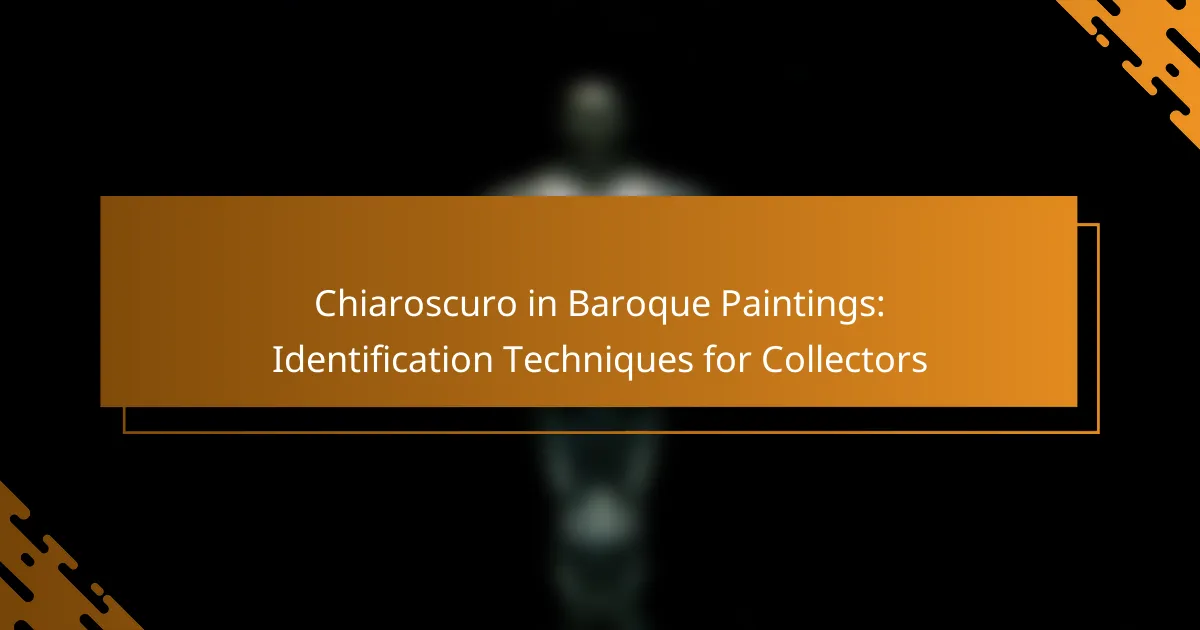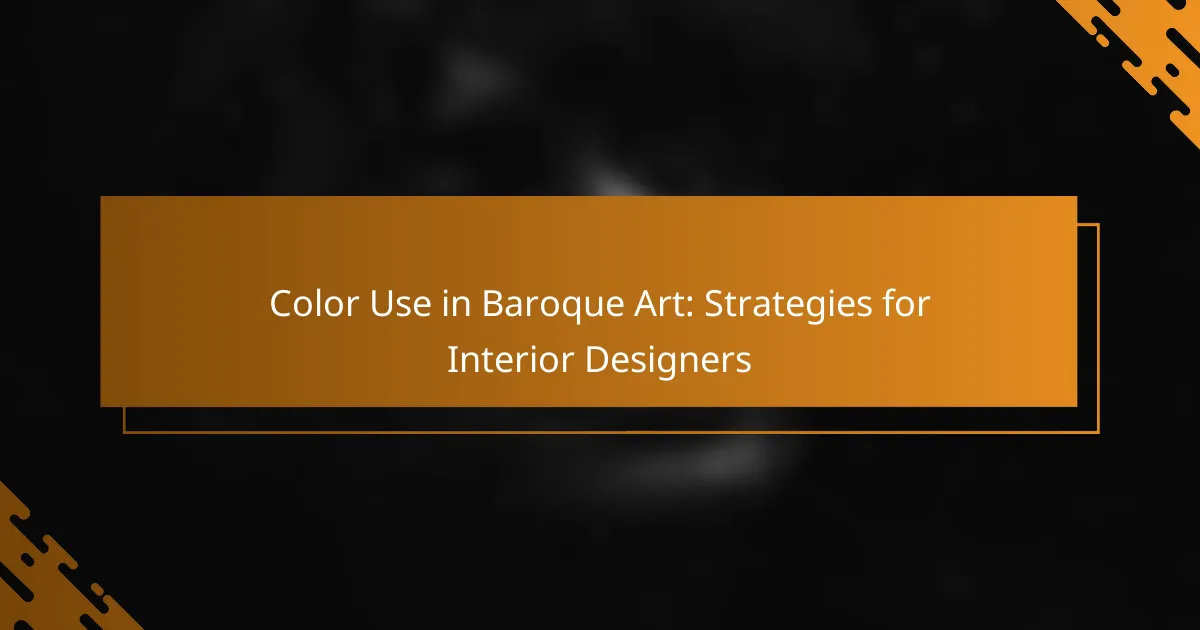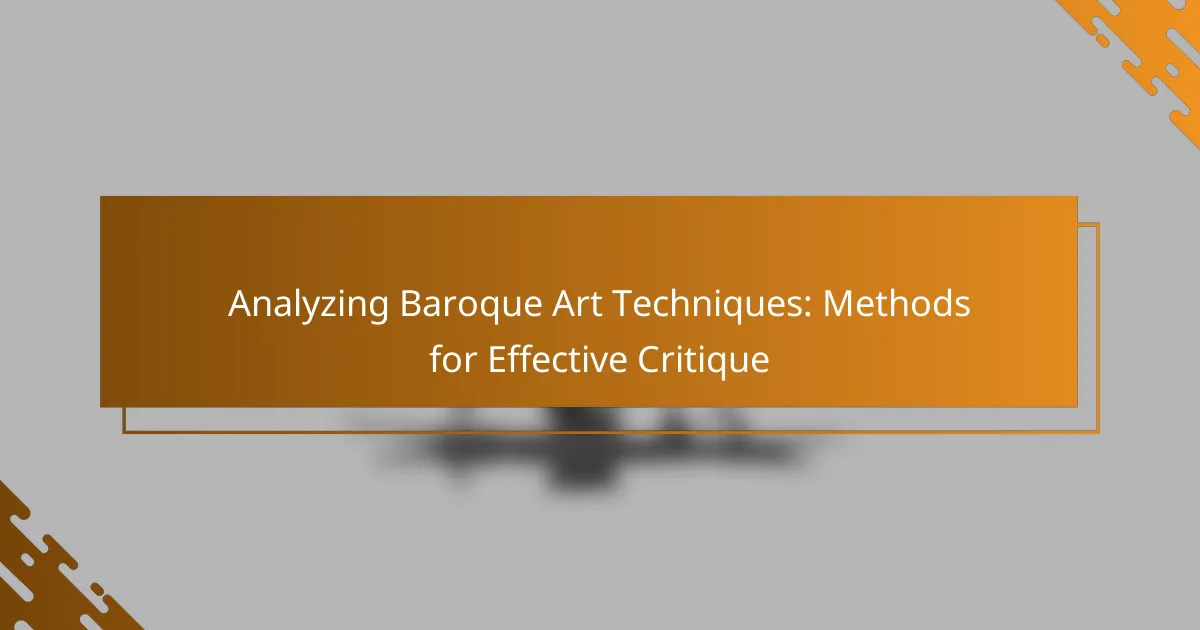Tenebrism, a hallmark of Baroque art, utilizes dramatic contrasts between light and dark to evoke emotional depth and enhance narrative engagement. This technique not only creates a sense of volume and depth but also directs the viewer’s attention to key elements within a composition. For students, incorporating Tenebrism into their art projects can significantly elevate the emotional impact and overall effectiveness of their work.
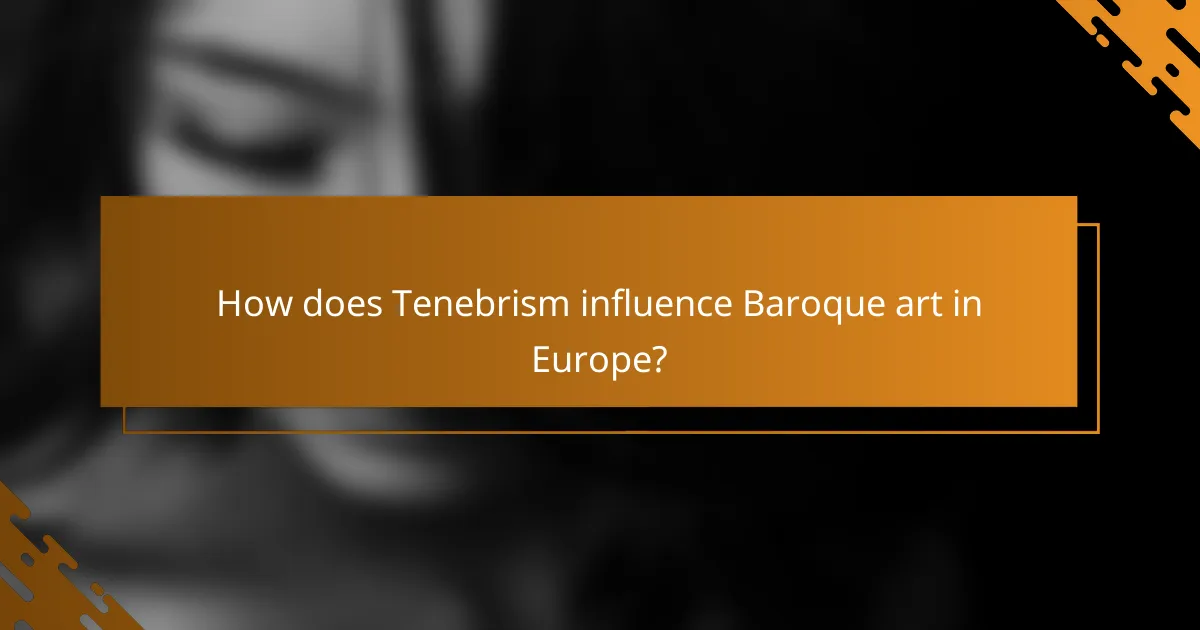
How does Tenebrism influence Baroque art in Europe?
Tenebrism significantly influences Baroque art in Europe by employing stark contrasts between light and dark to create dramatic visual effects. This technique enhances the emotional depth of artworks, drawing viewers into the narrative and intensifying the overall experience.
Creates dramatic contrasts
Tenebrism is characterized by its use of pronounced contrasts between illuminated areas and shadowy backgrounds. This technique not only highlights specific subjects but also adds a sense of movement and tension within the composition. Artists like Caravaggio utilized these contrasts to guide the viewer’s eye and emphasize key elements of the scene.
By manipulating light and shadow, artists can create a three-dimensional effect, making figures appear more lifelike. This approach was revolutionary in the Baroque period, as it moved away from the flatter representations of the preceding Renaissance era.
Enhances emotional impact
The emotional impact of Baroque art is greatly enhanced through the use of tenebrism. By casting certain figures in shadow, artists evoke feelings of mystery, drama, and even despair. This emotional resonance invites viewers to engage more deeply with the artwork.
For example, in Caravaggio’s “Judith Beheading Holofernes,” the stark lighting accentuates the tension and horror of the moment, making the viewer feel the weight of the action. Such emotional depth is a hallmark of Baroque art, setting it apart from earlier styles.
Prominent in Caravaggio’s works
Caravaggio is often regarded as the master of tenebrism, using this technique to redefine the portrayal of religious and mythological subjects. His works, such as “The Calling of Saint Matthew,” showcase how light can be used not just for illumination but as a narrative device.
In Caravaggio’s paintings, the interplay of light and shadow serves to heighten the drama and draw attention to the emotional states of the figures. This approach has influenced countless artists and remains a defining characteristic of Baroque art.
Used by Rembrandt for depth
Rembrandt also effectively employed tenebrism to add depth and dimension to his portraits and historical scenes. His use of light not only illuminates the subjects but also creates a rich atmosphere that invites contemplation.
In works like “The Night Watch,” Rembrandt’s strategic lighting enhances the three-dimensionality of the figures while also creating a sense of narrative urgency. This technique allows viewers to feel as though they are part of the scene, further immersing them in the artwork.

What are the key characteristics of Tenebrism?
Tenebrism is a painting technique characterized by dramatic contrasts between light and dark, creating a sense of volume and depth. This style, prominent in Baroque art, emphasizes the emotional intensity of the subject matter through its striking use of chiaroscuro.
Strong chiaroscuro effects
Chiaroscuro, the use of strong contrasts between light and dark, is a fundamental characteristic of Tenebrism. Artists utilize this technique to create a three-dimensional effect, enhancing the visual drama of their compositions. The stark differences in light intensity draw the viewer’s eye to focal points within the artwork.
For example, Caravaggio’s works often feature figures illuminated by a single light source, casting deep shadows that enhance the emotional impact. This method not only adds depth but also guides the viewer’s attention to the narrative elements of the painting.
Focus on light and shadow
The focus on light and shadow in Tenebrism serves to heighten the emotional atmosphere of a piece. Artists carefully manipulate light to create mood and tension, often using it to symbolize themes such as divinity or morality. The interplay of light and shadow can evoke feelings of drama and suspense.
In many Tenebrist paintings, the background is often dark, which allows the illuminated subjects to stand out starkly. This technique can be seen in works by artists like Rembrandt, where the subtle gradations of light create a rich, immersive experience for the viewer.
Emphasis on realism
Tenebrism also emphasizes realism, as artists strive to depict subjects with a lifelike quality. This focus on realism is achieved through detailed rendering of textures, facial expressions, and the effects of light on different surfaces. The realistic portrayal of human figures and emotions makes the scenes more relatable and impactful.
For students studying Tenebrism, understanding how to balance light and shadow while maintaining realism is crucial. Practicing with still life or portrait studies can help develop these skills, allowing for a deeper appreciation of how light influences perception in art.

How can students apply Tenebrism in their art projects?
Students can apply Tenebrism in their art projects by emphasizing strong contrasts between light and dark to create dramatic effects. This technique enhances the emotional impact of their work and helps to direct the viewer’s attention to focal points within the composition.
Utilizing light sources effectively
To effectively utilize light sources in Tenebrism, students should consider the direction and intensity of light in their compositions. A single, strong light source can create stark shadows and highlight specific areas, enhancing the overall drama. For example, positioning a light source at an angle can produce dynamic contrasts that draw the eye to the subject.
Experimenting with natural or artificial light can yield different effects. Students might use a lamp or window light to see how shadows shift throughout the day, allowing them to capture varying moods in their artwork.
Incorporating dramatic themes
Dramatic themes are central to Tenebrism, often conveying tension or emotion. Students should think about narratives that evoke strong feelings, such as conflict, solitude, or revelation. For instance, depicting a moment of struggle or triumph can enhance the emotional resonance of the artwork.
Incorporating figures in action or using symbolic elements can further amplify the drama. Students might consider historical or mythological themes that lend themselves well to intense storytelling through visual art.
Experimenting with color contrasts
Color contrasts play a crucial role in Tenebrism, complementing the light and dark elements. Students should explore using a limited color palette to enhance the impact of their work. For example, pairing warm colors with cool tones can create a striking visual tension that draws attention to the focal points.
Additionally, students can experiment with complementary colors to create vibrancy against dark backgrounds. This approach not only highlights the subject but also adds depth and interest to the overall composition, making the artwork more engaging.
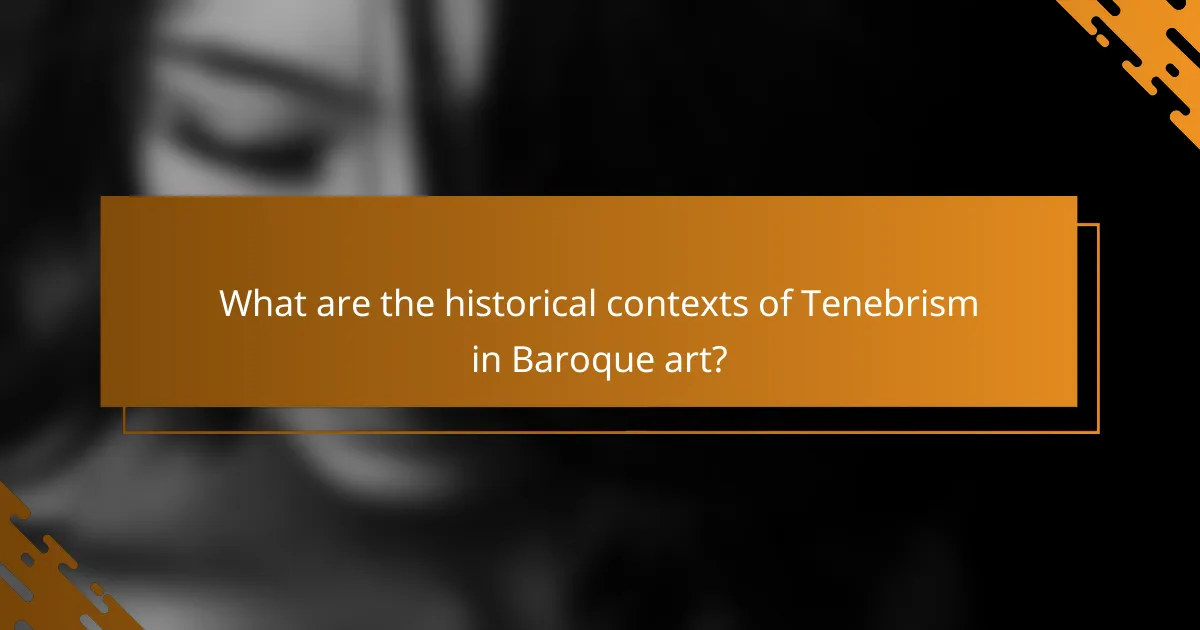
What are the historical contexts of Tenebrism in Baroque art?
Tenebrism, characterized by dramatic contrasts of light and shadow, emerged during the Baroque period, significantly influencing the art of the time. Its historical contexts include its origins in the late 16th century, its connection to the Catholic Counter-Reformation, and its adoption by various European artists.
Originated in late 16th century
Tenebrism originated in the late 16th century as artists began to explore the emotional power of light and shadow. This technique was notably used by Caravaggio, whose works exemplified the stark contrasts that define Tenebrism. The style marked a departure from the more balanced lighting of the Renaissance, focusing instead on intense illumination that directed viewer attention.
Artists utilized Tenebrism to create a sense of drama and tension within their compositions. This approach not only enhanced the narrative quality of paintings but also engaged viewers on a deeper emotional level, making the art more impactful.
Influenced by Catholic Counter-Reformation
The Catholic Counter-Reformation played a crucial role in the development of Tenebrism, as the Church sought to inspire faith through art. Artists were encouraged to depict religious themes with heightened emotional intensity, using light and shadow to evoke spiritual experiences. This was particularly effective in conveying the drama of biblical narratives.
Tenebrism became a tool for religious propaganda, emphasizing the divine and the miraculous. The stark contrasts in light not only drew attention to the central figures but also symbolized the struggle between good and evil, aligning with the Church’s goals during this tumultuous period.
Adopted by various European artists
Following its inception, Tenebrism was adopted by numerous European artists across different countries, each interpreting the style in unique ways. Besides Caravaggio, artists such as Rembrandt in the Netherlands and Georges de La Tour in France incorporated Tenebrist techniques into their works, showcasing their own cultural contexts.
This widespread adoption led to a rich variety of interpretations, with some artists focusing on the psychological aspects of light and shadow, while others emphasized the dramatic storytelling inherent in Tenebrism. The technique became a hallmark of Baroque art, influencing generations of artists and leaving a lasting legacy in the art world.

What are the best resources for studying Tenebrism?
To study Tenebrism effectively, consider a mix of art history textbooks, online courses, and documentaries that focus on Baroque art and its key figures. These resources provide foundational knowledge and visual examples that enhance understanding of this dramatic painting technique.
Art history textbooks
Art history textbooks are essential for grasping the context and evolution of Tenebrism within the Baroque period. Look for comprehensive texts that cover major artists like Caravaggio, who pioneered this style, and include discussions on light and shadow techniques.
Recommended titles often include “Art Through the Ages” and “Baroque Art: A Cultural History.” These books typically feature high-quality images and critical analyses that can deepen your appreciation of Tenebrism.
Online courses on Baroque art
Online courses offer structured learning about Baroque art and Tenebrism, often featuring video lectures, quizzes, and interactive content. Platforms like Coursera and edX provide courses from reputable universities that can be accessed for free or at a low cost.
When selecting a course, look for those that emphasize visual analysis and include modules specifically on Tenebrism. These can help you understand the technique’s application in various artworks and its impact on the art world.
Documentaries on Caravaggio
Documentaries focusing on Caravaggio are invaluable for visual learners interested in Tenebrism. These films often explore his life, artistic methods, and the historical context of his work, providing insights into how he mastered light and shadow.
Consider watching titles like “Caravaggio: The Soul and the Blood” or “Inside the Vatican,” which feature segments on his influence. These documentaries can enhance your understanding of Tenebrism by showcasing the emotional depth and drama that characterize his paintings.

